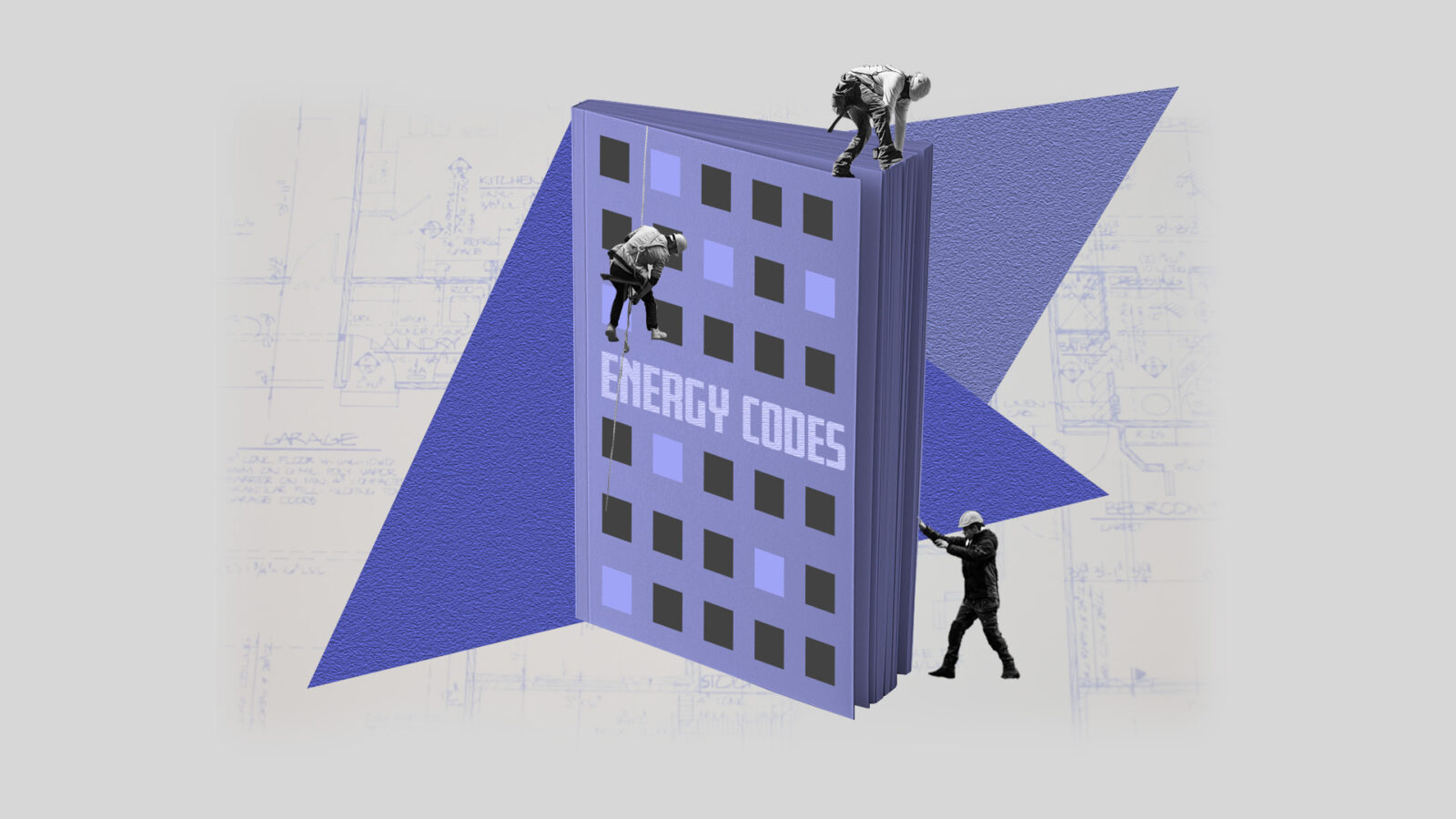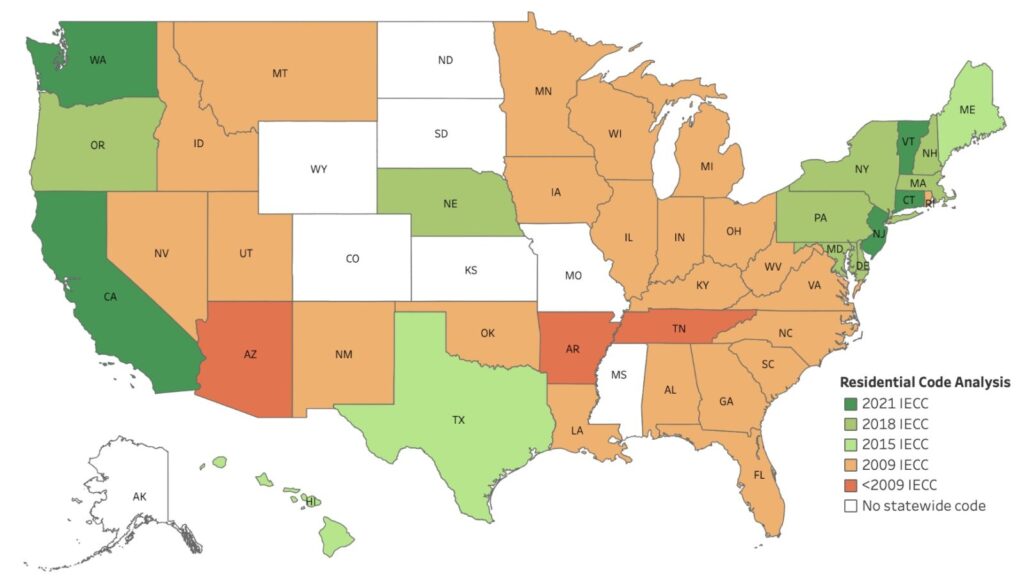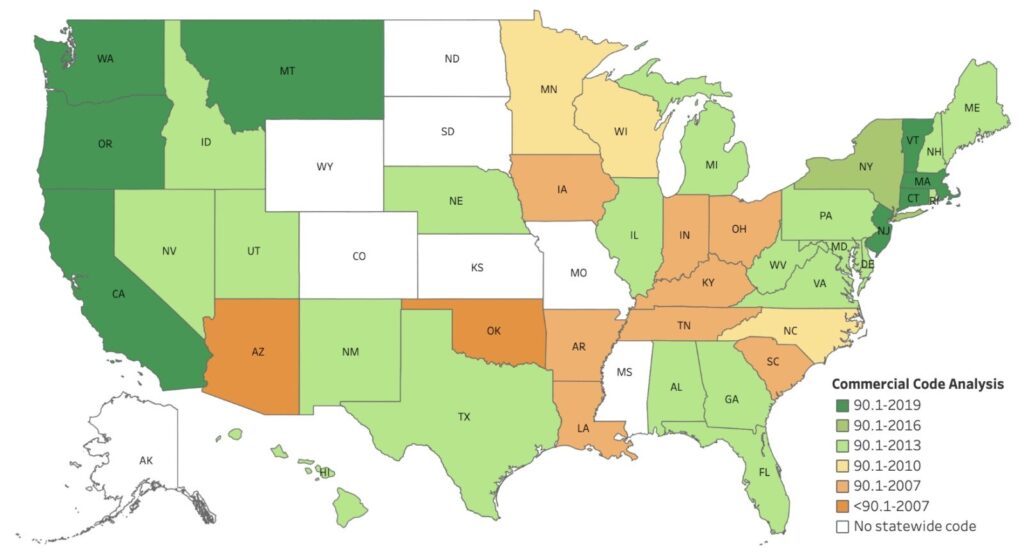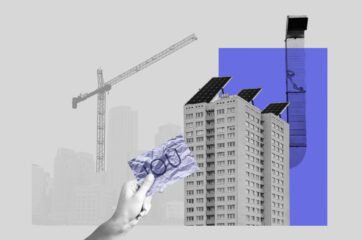Climate XChange’s Dashboard Digest is a deep dive on each of the policies that we track in the State Climate Policy Dashboard and an exploration of how these policies can interact with one another to form a robust policy landscape. The series is intended to serve as a resource to state policy actors who are seeking to increase their understanding of climate policies, learn from experts in each policy area, and view examples of states that have passed model policies.
Commercial and residential buildings account for more than one third of the country’s total greenhouse gas emissions, and making them more efficient can lead to immediate and long term environmental, health, and economic benefits. States have numerous ways to incentivize building owners to update existing, inefficient buildings, but energy codes are one of the best ways to make sure new buildings support climate goals.
Residential and commercial energy codes set minimum standards for energy efficiency practices in new construction, and since buildings have a lifespan of many decades or longer, the benefits from energy codes can compound for decades. The U.S. has no federal energy code, so states are left to decide if and how they will adopt energy codes, and because they are constantly updating due to evolving technology, a state’s progress is never complete.
In this article for our Dashboard Digest series, we’ll take a look at energy codes: how they are developed and adopted, how they differ between states, and what resources are available to make sure that they stay up to date.
What Are Energy Codes?
Building codes dictate the minimum standards for many aspects of new construction focused on health and safety. Energy codes are a subset of building codes that establish minimum levels of energy efficiency when constructing a building. They can dictate specific materials and practices that must be used, or have some other system to assess energy efficiency in the building.
Generally, states have separate energy codes for commercial and residential buildings, and the code specifies which classes of buildings are covered. While other policies tackle energy inefficiency in existing buildings, energy codes address new construction (e.g. new buildings, remodeling, additions). Energy codes set standards for building materials, design, and construction practices for walls, floors, ceilings, lighting, windows, doors and other parts of a building. They are different from appliance and equipment standards, because energy codes apply to the structure itself.
Learn more about other Buildings & Efficiency policies on our Dashboard Resource Hub.
READ MORE >
Energy codes are a regulatory instrument that can work in conjunction with other energy efficiency incentives and policies. For example, California’s newest energy code requires solar panels and energy storage to be installed on most new residential and commercial buildings in the state.
How are Energy Codes Developed?
There are two major organizations that develop the energy codes that are used by the majority of states: the International Code Council (ICC) and the American Society of Heating, Refrigerating, and Air-Conditioning Engineers (ASHRAE). Both organizations develop commercial and residential energy codes, however states typically use the ICC’s International Energy Conservation Code (IECC) for either residential or commercial buildings and ASHRAE’s 90.1 just for commercial ones.
Both of these organizations publish new, more stringent energy codes every three years, but the development process is continuous. Any stakeholder can submit proposals to amend the current energy codes with the final codes finalized after a voting process. While the U.S. has no federal energy code, the Department of Energy does have a Building Energy Codes Program which participates in the stakeholder proposal process, analyzes the cost effectiveness of new model codes, and assists states with their implementation.
How do States Adopt Energy Codes?
Once new codes are published, states have the opportunity to adopt the model code (or parts of it), write their own energy codes, or leave the decision to local governments and forgo a statewide code. Legislation or executive orders can direct a state agency to issue regulations that adopt or update energy codes. In some states, like Washington, a statewide building code council has the authority to write codes.
If an energy code is adopted at the state level, like the most recent version of IECC or ASHRAE, the code is uniform for all buildings across the state. This is probably the simplest option, because the state chooses to adopt a prewritten standard and has local governments enforce compliance with the code. Some states, like California, instead adopt their own energy codes instead of referencing a model code.
Given the evolving nature of energy codes, not all state codes are always up-to-date. Many state policies require the energy code be updated periodically or adopting the most recent versions of each code once it’s developed, but others do not. Some states even choose to instead adopt older, less stringent energy codes instead of the most recently developed version.
Some states choose to pass off energy code adoption to local governments through a constitutional provision known as home rule. In home rule states, towns and cities are given greater autonomy to govern themselves, including choosing to adopt their own energy codes. In states without home rule, authority remains at the state level or must be specifically granted to local governments. Home rule differs in each state, with some granting authority to any city that elects to adopt it and others that limit the option to certain cities. Kansas, for example, is a home rule state with no statewide residential building code and leaves the decision to adopt one up to each municipality.
Stretch Codes
Some states have passed legislation that allows local jurisdictions to adopt even stricter energy codes than what exists at the state level. In these cases, the statewide code is known as the base code and the more stringent one is a stretch code. Stretch codes may be structured similarly to the base code, with specific construction requirements, or they may be performance based and require energy savings targets.
Massachusetts was one of the first states to adopt a stretch code in 2009. The current MA base code references the 2018 IECC while the stretch code uses the more recent 2021 IECC with state-specific amendments to each. If a city adopts the code they are designated a “Green Community” and can receive additional state support and take advantage of utility rebates and other incentives.
Why are Energy Codes Important?
Long Term Energy Benefits
Since buildings are designed to be around for a long time, strong energy codes can ensure that they are built in a way that supports state climate goals, whereas weak or no codes can result in buildings that lock in avoidable emissions for decades or longer. The Department of Energy projects that model energy codes could avoid 900 million metric tons of carbon dioxide emissions — or what 227 coal power plants release each year.
Recent energy codes from the ICC (2021 IECC) and ASHRAE (90.1-2019) have the potential to save 30 percent more energy than the equivalent codes from a decade earlier, according to a Department of Energy analysis. This underscores the importance for states to keep their energy codes up to date to maximize energy savings.
Equity Impacts
Low-income households are more likely to rent their homes, which are often inefficient buildings. Landlords are typically unwilling to pay for building upgrades because it’s the renter that sees the financial benefits, and renters are unlikely or unable to pay for building upgrades. Having up-to-date energy codes is one of the best ways to ensure that multi-family housing buildings are made efficiently, which can have financial and health benefits for residents.
Having an efficient home can also help address energy insecurity, which is the inability to adequately meet basic energy needs. This includes reducing or forgoing basic necessities to pay for energy bills, receiving disconnection notices, or keeping the home at unsafe temperatures. In 2020, more than one in four U.S. households had difficulty meeting their energy needs, with the greatest percentage in Southern states. More than 15 million households in the South report experiencing energy insecurity and statewide energy codes lag behind the rest of the nation.
Economic Impacts
One goal of these policies is to ensure that the benefits outweigh the costs of adopting energy codes. The Pacific Northwest National Laboratory (PNNL) analyzed the cost effectiveness for what would happen if every state (except for a few that use custom energy codes) adopted ASHRAE 90.1-2019 for commercial buildings and 2021 IECC for residential buildings. For example, PNNL found that if Louisiana adopts the 2021 IECC for residential buildings, the average life-cycle cost of all dwellings will be reduced by about $13,000 over a 30 year period when compared with the energy code that’s already in place (2009 IECC).
A Department of Energy analysis found that implementing model building energy codes across the country could save home and business owners $138 billion in energy costs over a 30-year period.
What's the Current State of this Policy?
Statewide energy codes have been widely adopted across the U.S., but nine states lack residential and commercial energy codes. Even among the states that do have energy codes in place, many are not up to date. The ICC’s most recent code was developed in 2021, but so far just four states have adopted that version for residential buildings. Seven states have adopted the ASHRAE 90.1-2019 code for commercial buildings.
ASHRAE released it’s newest energy code in January 2023, but it hasn’t yet been adopted by any state.
READ MORE >
What Can States Do?
Energy codes are a vital resource to increase efficiency in buildings which is key for states to reach their climate targets. One of the reasons that this policy is so important, is that it’s dynamic — even as states update their energy codes, new, more efficient codes are already being developed and states will need to adopt those to stay up to date.
Depending on where a state is with energy codes, there are a few key actions that states can take:
Adopt Statewide Energy Codes
There are nine states that have not adopted residential or commercial energy codes: Alaska, Arizona, Wyoming, Colorado, North Dakota, South Dakota, Kansas, Missouri, and Mississippi. All of these states currently have home rule in place, giving communities the choice to adopt energy codes. While it is good that some communities have adopted them, implementing a statewide code would bring forward towns and cities that are lagging behind.
Financial costs are one of the most significant barriers to energy code adoption. When a state or local government imposes stricter energy codes, it can lead to increased costs for construction from more expensive materials and additional labor and training. This can lead to resistance from building developers and other stakeholders who worry that energy codes will cut into profits or pass costs onto buyers.
State and local governments also incur costs to implement and enforce their energy codes. These costs can come from purchasing codebooks and other physical materials, updating compliance programs, and hiring additional code enforcement officials to handle the additional inspections.
States that are considering adopting or updating energy codes should perform cost-benefit analyses, or utilize resources from the DOE Building Energy Codes Program. This information can help communicate that the benefits of adopting energy codes outweigh the costs over the life-cycle of buildings.
Use Federal Funding to Address Costs
Recent federal funding has been made available for states to update and adopt energy codes through the Infrastructure Investment and Jobs Act (IIJA) and the Inflation Reduction Act (IRA).
The IIJA allocates $225 million to update building energy codes and support their implementation. The funding will be awarded through a competitive grant process to relevant state agencies, with $45 million set aside annually for five years. Implementation programs can include workforce development initiatives, like energy code training programs and mapping of career pathways in building codes, tools and other resources to increase code compliance, and resources that support in-field assessments. The American Council for an Energy-Efficient Economy (ACEEE) identified ten states that could benefit the most from this federal funding, factoring in overall energy savings as well as existing building emissions and new construction activity in the state.
Additional federal funding will be made available through the Inflation Reduction Act (IRA) which was passed in August of last year. The IRA Section 50131: Assistance for Latest and Zero Building Energy Code Adoption allocates $1 billion in competitive grants to support adoption and implementation of the latest model energy codes and zero energy codes. This assistance is available to states and units of local government that have the authority to adopt energy codes, so notably it can be used in states with no statewide energy code. There’s no timeline on when this funding will be made available, but the grants are scheduled to run through September 30, 2029.
Regularly Update Energy Codes
It’s important that states are continually updating their energy codes because model codes are developed every three years. Sometimes energy code adoption processes can leave states years behind the most recently developed codes. Some laws allow the state to adopt a new energy code at any time, but most are restricted to wait for a certain time period, often three years. This timeline does match up with the ICC and ASHRAE code development process, but if these periods aren’t in sync then it can result in states being a few years behind. Some states may even forgo the adoption of a certain year’s code in order to adopt a more stringent one in the future. For example, New York uses 2018 IECC for its residential energy code, even though 2021 is the most recent year, however the state plans to adopt the 2024 IECC update once it’s developed.
States can have a codified process or administrative body to update their energy codes to ensure that they’re up to date. Washington’s Building Code Council has the authority to update building codes and advise the legislature on related policies. The council is responsible for updating state codes every three years and recently adopted the 2021 Washington State Building Code in December of last year.
State Example
Vermont
According to the Department of Energy, Vermont has some of the most efficient energy codes in the nation, with their residential and commercial energy codes being more efficient than the most recently developed ones from ICC and ASHRAE.
Vermont’s residential energy code, the Residential Building Energy Standard (RBES) was first adopted in 1997 and most recently updated in 2020. RBES applies to all new residential construction including additions, alterations, and repairs of existing buildings. It’s written into the law that the Commissioner of Public Service will update the code “promptly” after there are newly updated standards from the ICC.
Vermont also has a stretch code which can be adopted by local jurisdictions. The stretch code applies to new construction in towns that choose to adopt it as well as anything that qualifies as an Act 250 project. Act 250 was passed in 1970 and required certain construction to use energy conservation measures with the best available technology. The stretch code includes a greater emphasis on insulation practices, fresh air ventilation system, and an overall greater amount of points that buildings must earn to achieve compliance.
The state’s commercial energy code, the Commercial Building Energy Standards (CBES), was enacted in 2006 and is required to be updated every three years. Vermont is currently in the process of updating the code which is expected to be in effect in September 2023. CBES applies to all commercial buildings and residential buildings that are four stories or higher.
CBES is based on the 2018 IECC, but offers an alternative compliance path using ASHRAE 90.1-2016. It should be noted that even though the state’s commercial energy code doesn’t reference the most up-to-date model codes, state amendments make it 3.1 percent more efficient than the current ASHRAE 90.1 code, according to the Department of Energy.









